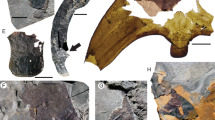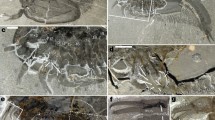Abstract
Enosiaspis hrungnir gen. et sp. nov., a new species of marrellomorph arthropod from the Lower Ordovician (Tremadocian) Fezouata biota of Morocco, is described. This taxon is characterised by the possession of a cordiform dorsal carapace with an anterior notch and a doublure-like structure formed from fused marginal spines, covering the entire body. The head comprises at least five segments which bear an anterior pair of antenna, followed by three pairs of potentially biramous, geniculate appendages. The trunk possesses around 25 pairs of delicate, almost filamentous appendages, which decrease in size posteriorly. Similar features are also found in Xylokorys chledophilia from the Silurian of England, and Vachonisia rogeri from the Devonian of Germany, indicating acercostracan affinities for E. hrungnir. This was tested using a phylogenetic analysis which resolved this taxon as sister taxon to a group composed of the formerly mentioned taxa. The similarities between the ventral spinose carapace doublure of E. hrungnir and the mediolateral spines of marrellid marrellomorphs further support claims that the dorsal shield of acercostracans evolved from the fusion of spinose anlagen, akin to the formation of the carapace of crustaceans.




Similar content being viewed by others
References
Beurlen K (1930) Vergleichende Stammesgeschichte Grundlagen, Methoden, Probleme unter besonderer Berücksichtigung der höheren Krebse. Fortschr Geol Paläontol 8:317–586
Destombes J, Hollard H, Willefert S (1985) Lower Paleozoic rocks of Morocco. In: Holland CH (ed) Lower Paleozoic of North-Western and West-Central Africa. Wiley, New York, pp 91–336
Gabbott SE, Hou XG, Norry MJ, Siveter DJ (2004) Preservation of Early Cambrian animals of the Chengjiang biota. Geology 32:901–904
García-Bellido DC, Collins DH (2006) A new study of Marrella splendens (Arthropoda, Marrellomorpha) from the Middle Cambrian Burgess Shale, British Columbia, Canada. Can J Earth Sci 43:721–742
Goloboff PA (1999) Analysing large data sets in reasonable times: solutions for composite optima. Cladistics 15:415–428
Goloboff PA, Farris JS, Nixon KC (2008) TNT, a free program for phylogenetic analysis. Cladistics 24:774–786
Kühl G, Bergström J, Rust J (2008) Morphology, palaeobiology and phylogenetic position of Vachonisia rogeri (Arthropoda) from the Lower Devonian Hunsrück Slate (Germany). Palaeontogr Abt A 286:123–157
Legg DA (2015) The morphology and affinities of Skania fragilis (Arthropoda) from the middle Cambrian Burgess Shale. Bull Geosci 90:509–518
Legg DA, Hearing TW (2015) A late surviving xenopod (Arthropoda) from the Ordovician Period, Wales. Geol Mag 152:942–948
Legg DA, Sutton MD, Edgecombe GD (2013) Arthropod fossil data increase congruence of morphological and molecular phylogenies. Nat Commun 4:2485
Lehmann WM (1955) Vachonia rogeri n. g. n. sp. – Ein Brachiopod aus dem Unterdevonischen Hunsrückschiefer. Paläontol Z 29:126–130
Lehmann WM (1956) Vachonisia nov. gen. anstatt Vachonia. Paläontol Z 30:225
Lerosey-Aubril R, Ortega-Hernández J, Kier C, Bonino E (2013) Occurrence of the Ordovician-type aglaspidid Tremaglaspis in the Cambrian Weeks Formation (Utah, USA). Geol Mag 150:945–951
Lin J-P et al (2006) A Parvancorina-like arthropod from the Cambrian of South China. Hist Biol 18:33–45
Martin ELO et al (2015) The Lower Ordovician Fezouata Konservat-Lagerstätte from Morocco: age, environment and evolutionary perspectives. Gondwana Research. in press
Nixon KC (1999) The Parsimony Ratchet, a new method for rapid parsimony analysis. Cladistics 15:407–414
Olesen J (2013) The crustacean carapace: morphology, function, development, and phylogenetic history. In: Watling I, Thiel M (eds) The natural history of Crustacea. Oxford University Press, 1:103–139
Rak Š, Ortega-Hernández J, Legg DA (2013) A revision of the Late Ordovician marrellomorph arthropod Furca bohemica from Czech Republic. Acta Palaeontol Pol 58:615–628
Sepkoski JJ Jr (1981) A factor analytical description of the Phanerozoic marine fossil record. Paleobiology 7:36–53
Sepkoski JJ Jr (1995) The Ordovician radiations: diversification and extinction shown by global genus-level taxonomic data. In: Cooper JD, Droser MJ, Finney SC (eds) Ordovician Odyssey: Short papers from the Seventh International Symposium on the Ordovician System. Pacific Society for Sedimentary Geology (SEPM), Fullerton, pp 393–396
Servais T, Owen AW, Harper DAT, Kröger B, Munnecke A (2010) The Great Ordovician Biodiversification Event (GOBE): The palaeoecological dimension. Palaeogeogr Palaeoclimatol Palaeoecol 294:99–119
Siveter DJ, Fortey RA, Sutton MD, Briggs DEG, Siveter DJ (2007) A Silurian ‘marrellomorph’ arthropod. Proc R Soc B 274:2223–2229
Siveter DJ, Briggs DEG, Siveter DJ, Sutton MD, Legg DA, Joomun S (2014) A Silurian short-great-appendage arthropod. Proc R Soc B 281:20132986
Tasch P (1969) Branchiopoda. In: Moore RC (ed) Treatise on invertebrate paleontology. Part R. Arthropoda. Geological Society of America and University of Kansas Press, Lawrence, 4(1):R128–R191
Van Roy P (2006) Non-trilobite arthropods from the Ordovician of Morocco. PhD thesis, Ghent University
Van Roy P, Briggs DEG (2011) A giant Ordovician anomalocaridid. Nature 473:510–513
Van Roy P, Orr PJ, Botting JP, Muir LA, Vinther J, Lefebvre B, el Hariri K, Briggs DEG (2010) Ordovician faunas of Burgess Shale type. Nature 465:215–218
Van Roy P, Briggs DEG, Gaines RR (2015a) The Fezouata fossils of Morocco; an extraordinary record of marine life in the Early Ordovician. J Geol Soc 172:541–549
Van Roy P, Daley AC, Briggs DEG (2015b) Anomalocaridid trunk limb homology revealed by a giant filter-feeder with paired flaps. Nature 522:77–80
Vinther J, Van Roy P, Briggs DEG (2008) Machaeridians are Palaeozoic armoured annelids. Nature 451:185–188
von Siebold CT (1848) Lehrbuch der vergleichenden Anatomie der Wirbellosen Thiere. Erster Theil. In: von Siebold CT, Stannius H (eds) Lehrbuch der vergleichenden Anatomie. Verlag von Veit & Comp, Berlin, 679 pp
Walcott CD (1931) Addenda to descriptions of Burgess Shale fossils. Smithson Misc Collect 85:1–46
Zhang X-L, Han J, Zhang ZF, Liu HQ, Shu DG (2003) Reconsideration of the supposed naraoiid larva from the Early Cambrian Chengjiang Lagerstätte, South China. Palaeontology 46:447–465
Acknowledgments
This work was made possible through the extensive help and support of Peter Van Roy (Yale University, New Haven). Thanks are also due to Susan Butts and Jessica Utrup (both Yale Peabody Museum) for access to specimens in their care, and for providing loans of specimens. Work on the material described in this paper was made possible by NSF Grant EAR-1053247.
Author information
Authors and Affiliations
Corresponding author
Additional information
Communicated by: Sven Thatje
Electronic supplementary material
Below is the link to the electronic supplementary material.
Supplementary figure 1
(DOCX 471 kb)
Supplementary table 1
(DOCX 15 kb)
Supplementary figure 2
(DOCX 2636 kb)
ESM 1
(DOCX 13 kb)
ESM 2
(TXT 467 kb)
ESM 3
(TXT 467 kb)
ESM 4
(XLSX 988 kb)
Rights and permissions
About this article
Cite this article
Legg, D.A. An acercostracan marrellomorph (Euarthropoda) from the Lower Ordovician of Morocco. Sci Nat 103, 21 (2016). https://doi.org/10.1007/s00114-016-1352-5
Received:
Revised:
Accepted:
Published:
DOI: https://doi.org/10.1007/s00114-016-1352-5




